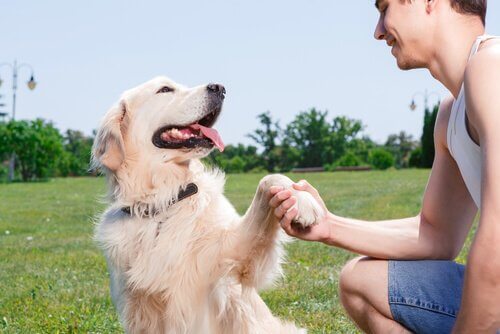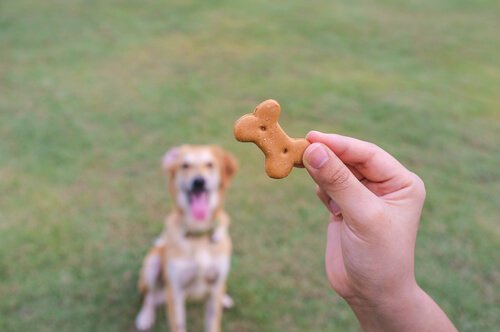5 Tricks to Make Your Dog Respond to Your Call

Is there anything more annoying than when your dog doesn’t respond when you call his name? Getting your dog to obey commands is difficult, but it’s not impossible. In this article, we’ll share some tricks with you to help you get your dog to respond to your call.
Tips to get your dog to respond to your call
Establish eye contact with your dog

If you want your dog to respond to your call, it’s really important to establish trust with him and create a strong bond.
Eye contact is a really good way of doing this. If you look straight into your dog’s eyes when you’re talking to him, it’ll help establish that loving and trusting bond you need. This way he’ll be much more motivated to obey your commands.
Be sure to do it whenever you talk to him or play with him. For example, place one of his toys in front of him but don’t let him pick it up. Eventually, he will look up at you as a way of “asking” if he can have it.
Don’t get angry if he doesn’t respond
If your dog doesn’t respond to your call, don’t get angry. It won’t achieve anything and may even scare your dog instead. Be patient and try to stay affectionate even if he doesn’t obey your commands. Try to attract his attention and play with him so that he associates your call with something positive.
If you only ever call him to tell him off, then he’s just going to be scared of your call.
Remember, positive reinforcement works with animals just like with children.
Give him a reward when he obeys
Buy some snacks or treats that he likes and be generous with them each time he behaves well.
You can also use them to encourage him to obey your commands. If it’s something really tasty or attractive then he’s bound to come right away when you call his name. Little bits of sausage, ham, or dog treats (recommended by your vet) are a great way to get your dog to respond to your call.
Practice at home
If your dog doesn’t pay much attention to you in an enclosed space at home, then he’s even less likely to in the street where there are open places to explore.
This is why it’s important for this type of training to begin at home. At home, you’re in a smaller, enclosed space that your dog already knows well. This is a better chance to practice. Anytime he behaves well, give him some positive reinforcement, treats, and affection so that he links your call with something positive.
But be patient. He won’t always respond how you want, and you’ll need to keep your frustration in check.
Perseverance and consistency

If you give up the first time things don’t work then you’re not going to achieve anything. You can’t expect your dog to respond to you on the very first attempt. Perseverance and consistency are a key part of teaching your dog any kind of behavior or command.
Similarly, you need to be consistent with your rewards, affection, and positive reinforcement. If you dish out rewards one day but not the next then it’s a waste of time. Your dog won’t notice any kind of routine or pattern and certainly won’t know how to respond to your call.
Training your dog to respond to your commands isn’t easy. It requires a lot of effort, love, affection, and perseverance. But if you stick to these tips, you’ll get results. Remember, love is the very best tool you can use when training your dog. Good luck!
Is there anything more annoying than when your dog doesn’t respond when you call his name? Getting your dog to obey commands is difficult, but it’s not impossible. In this article, we’ll share some tricks with you to help you get your dog to respond to your call.
Tips to get your dog to respond to your call
Establish eye contact with your dog

If you want your dog to respond to your call, it’s really important to establish trust with him and create a strong bond.
Eye contact is a really good way of doing this. If you look straight into your dog’s eyes when you’re talking to him, it’ll help establish that loving and trusting bond you need. This way he’ll be much more motivated to obey your commands.
Be sure to do it whenever you talk to him or play with him. For example, place one of his toys in front of him but don’t let him pick it up. Eventually, he will look up at you as a way of “asking” if he can have it.
Don’t get angry if he doesn’t respond
If your dog doesn’t respond to your call, don’t get angry. It won’t achieve anything and may even scare your dog instead. Be patient and try to stay affectionate even if he doesn’t obey your commands. Try to attract his attention and play with him so that he associates your call with something positive.
If you only ever call him to tell him off, then he’s just going to be scared of your call.
Remember, positive reinforcement works with animals just like with children.
Give him a reward when he obeys
Buy some snacks or treats that he likes and be generous with them each time he behaves well.
You can also use them to encourage him to obey your commands. If it’s something really tasty or attractive then he’s bound to come right away when you call his name. Little bits of sausage, ham, or dog treats (recommended by your vet) are a great way to get your dog to respond to your call.
Practice at home
If your dog doesn’t pay much attention to you in an enclosed space at home, then he’s even less likely to in the street where there are open places to explore.
This is why it’s important for this type of training to begin at home. At home, you’re in a smaller, enclosed space that your dog already knows well. This is a better chance to practice. Anytime he behaves well, give him some positive reinforcement, treats, and affection so that he links your call with something positive.
But be patient. He won’t always respond how you want, and you’ll need to keep your frustration in check.
Perseverance and consistency

If you give up the first time things don’t work then you’re not going to achieve anything. You can’t expect your dog to respond to you on the very first attempt. Perseverance and consistency are a key part of teaching your dog any kind of behavior or command.
Similarly, you need to be consistent with your rewards, affection, and positive reinforcement. If you dish out rewards one day but not the next then it’s a waste of time. Your dog won’t notice any kind of routine or pattern and certainly won’t know how to respond to your call.
Training your dog to respond to your commands isn’t easy. It requires a lot of effort, love, affection, and perseverance. But if you stick to these tips, you’ll get results. Remember, love is the very best tool you can use when training your dog. Good luck!
This text is provided for informational purposes only and does not replace consultation with a professional. If in doubt, consult your specialist.








